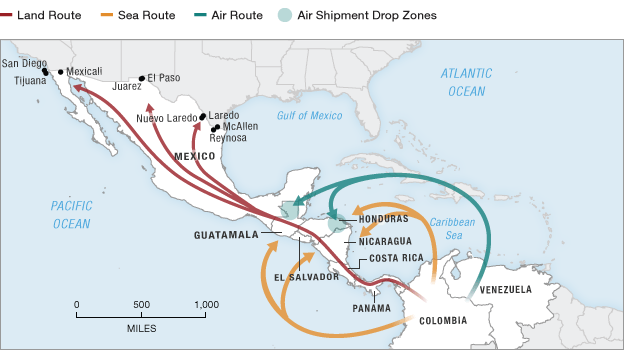How Latin America’s Parallel States Run Product, People, and Power to the U.S.
The cartels aren’t “gangs” and this isn’t just “crime.” It’s parallel governance: supply chains with flags, HR departments with rifles, and balance sheets that compete with midsize nations. If Washington is a bureaucracy with a military, the cartels are militaries with a bureaucracy—vertical, adaptive, and ruthlessly customer-centric. Treat them like random hoodlums and you’ll keep losing to an opponent that thinks in systems.
The business model (unromantic version)
At core, this is arbitrage with logistics:
- Source cheap, sell dear: coca leaf in the Andes, chemical precursors from Asia to Pacific ports, stolen oil and contraband anywhere margins appear.
- Own the bottlenecks: ports (Manzanillo, Lázaro Cárdenas), dry corridors (Tamaulipas, Ciudad Juárez, Nogales), jungle rivers, and migrant trails that double as courier lanes.
- Modularize risk: compartmentalize labs, stash houses, and transport so failures don’t cascade. If one cell gets rolled up, the rest of the supply chain barely flinches.
- Outsource deniability: subcontract to local “plaza” operators and migrant-smuggling networks; pay in cash, product, or protection.
It’s Amazon, if Amazon laundered money through bodegas, used accountants with AR-15s, and enforced SLAs with military-grade intimidation.
Mexico: the hub (and the rulebook)
Sinaloa runs like a family conglomerate—legacy capital, deep vendor relationships, and a bias for “quiet dominance.” CJNG is the blitzscaler—fast, brutal, and spectacular, absorbing or pulverizing mid-tier competitors. Both learned the same lesson from the old Zetas playbook: diversify revenue (narcotics + extortion + fuel theft + illegal mining + migrant taxation) and monetize territory, not just product. When the border becomes a turnstile, every turn is a toll.
Key edges:
- Port control + precursor mastery → fentanyl-era advantage.
- Financial plumbing → trade-based money laundering (fake invoices, under/over-invoicing), remittance splitting, crypto as a pressure-release valve (not the core pipe), and real-estate wash cycles.
- State capture → buy cops, threaten mayors, befriend contractors; if you can’t capture the state, be the state from 10 p.m. to sunrise.
Venezuela: the new fuse
When a petro-state implodes, supply chains don’t disappear—they repurpose. Venezuela’s crisis turned key organs into revenue engines: elements within the military (the “Cartel of the Suns”), corrupt port/police nodes, and allied groups that treat borders as suggestions. Result: alternative Caribbean and Atlantic lanes for cocaine outflow, gold smuggling to finance networks, and a growing role as a corridor and cash-out zone for regional actors who want redundancy outside Mexico’s glare.
Translation: if Mexico is the mainboard, Venezuela is the failover server.
Colombia: from kingpins to franchises
Colombia’s post-FARC landscape didn’t end the trade; it unbundled it. You now have splinter factions, ex-paramilitary bands, and local mafias running farm-to-wharf micro-chains. This fragmentation looks like weakness until you realize it’s resilience by design: multiple small suppliers feeding larger Mexican distributors with fewer “big tree” targets for prosecutors to chop down.
The fentanyl pivot: software update, not product change
Everyone keeps treating fentanyl like a new drug crisis. It’s a supply-chain revolution:
- Precursors: compact, concealable, ship friendly. Think “value density.”
- Micro-dosing + blending: lets mid-tier operators manufacture closer to end markets, flattening the chain.
- Lower shipping risk per dollar: powders beat plant mass every day of the week.
The overdose wave isn’t a “bug”; it’s the ugly artifact of an optimized margin structure colliding with a deregulated pill culture. Grim truth: the business case writes itself.
Migration markets: human logistics as recurring revenue
Smuggling and trafficking are now product lines with upsells:
- Bronze package: desert drop and a prayer.
- Silver: guided crossings, stash-house lodging, and transport to the interior.
- Gold: “full-stack” service—fake docs, work placements, and debt-collection enforcement back home if you fall behind.
Every surge at the border isn’t just a political story; it’s a demand spike. Every policy change creates a new pricing tier. Cartels watch rule shifts the way traders watch the Fed.
Information ops: fear is a feature
Videos of convoys and banners aren’t random terror; they’re brand management. The message: “We police at night; you pretend to by day.” Assassinations are PR with consequences—signal to rivals, punish defectors, set municipal policy without ever winning an election. Where the state is weak, the cartel rents legitimacy by mediating disputes, paying for funerals, or handing out food. A cynical social contract beats no contract at all.
Why the state keeps losing (in one paragraph)
Because the cartels own time (they don’t face election cycles), terrain (they monetize it like a landlord), talent (they pay better at the edges), and optionality (they pivot products and routes faster than regulators rewrite memos). We send task forces; they send accountants. We strive for arrests; they strive for redundancy. It’s not that the state can’t hit them—it’s that the state keeps swinging at nodes, not the network.
The leverage that actually matters
If you want to squeeze a networked enterprise, you attack the interfaces it can’t live without:
- Ports & precursors
Real, joint-ops control at maritime gateways (customs + port police + vetted special units), plus upstream work with India/China on precursor controls that bite. Random inspections don’t work; risk-based profiling and container analytics do. - Trade-based money laundering
Follow the invoices, not the Instagram. Embed auditors with subpoena teeth in free-trade zones; build shared ledgers (yes, boring) across customs, banks, and freight forwarders. Show me the “shrinkage” and I’ll show you the cash box. - Corruption chokepoints
Focus on municipal procurement and fuel distribution—the two favorite piggy banks. When a mayor controls garbage, water, and diesel, the cartel is standing behind him counting. - Insurance & compliance pressure
Carriers and warehouse operators respond to premiums. Tie loss ratios to verifiable compliance (CCTV retention, seal integrity, employee vetting). If a corridor’s loss history spikes, insurers price it and carriers exit. Markets do what memos can’t. - Migrant-route taxation
Treat smuggling as a revenue stream, not a sob story. Map toll points; sanction the local facilitators; freeze the hawala nodes. You don’t have to stop the flow to starve the margin. - Municipal resilience
Cartels thrive in towns where the state only exists from 9–5. Build off-budget municipal grants that harden nighttime policing, pay prosecutors enough to resist, and digitize land records (so extortionists can’t “reassign” property with a signature and a gun).
Mexico, Venezuela, Colombia: how the pieces click
- Mexico is the final assembler and primary distributor; it sets price and quality control on the border.
- Venezuela is the redundant router: an alternate export path, a laundering sink, and a logistics lab when heat rises elsewhere.
- Colombia is the ingredient market: diversified farm output and semi-independent processors who can swap buyers without a press release.
This isn’t three problems; it’s one system with three roles—and the U.S. is the terminal market that keeps the lights on.
The uncomfortable truth
As long as the U.S. consumer economy sustains insatiable demand, and as long as Latin American governance delivers predictable gaps, the cartels will look less like criminals and more like inefficient governments with excellent revenue growth. You don’t defeat that with speeches. You compete with it—on speed, on certainty, and on the one thing they can’t fabricate at scale: legitimacy.
What this sets up next
- Venezuela Hot Routes: emerging sea/air corridors, port nodes, and gold-for-cash loops.
- Money Plumbing 101: trade-based laundering, complicit vendors, and where the invoices hide.
- Border as Marketplace: how policy timing and “surge math” become cartel pricing events.
Citations
- Reuters – “Mexico’s Sinaloa, Jalisco cartels expand operations across the Americas, U.S. says” (March 13, 2024)
- Center for Strategic and International Studies – “The Evolution of Mexico’s Criminal Landscape” (May 2023)
- Brookings Institution – “The Globalization of Fentanyl and Its Precursors” (February 12, 2024)
- U.S. Department of the Treasury – “Sanctions on Venezuelan Cartel of the Suns Network” (October 3, 2023)
- InSight Crime – “How Venezuela’s Cartel of the Suns Functions” (June 27, 2023)
- U.N. Office on Drugs and Crime – “Cocaine trafficking through Venezuela: Routes and Trends” (2023)
- CSIS – “The Fentanyl Supply Chain: Mexico, China, and the United States” (October 5, 2023)
- GAO – “Drug Control: U.S. Efforts to Combat Fentanyl and Other Synthetic Opioids” (July 18, 2024)
- InSight Crime – “Colombia’s Cocaine Economy After the FARC” (April 19, 2024)
- Council on Foreign Relations – “How Cartels Govern Mexico” (November 15, 2023)


Pingback: Confront Caracas to Collapse the Axis - #TCOT Reporter
Pingback: Venezuela Hot Routes - #TCOT Reporter
Pingback: Money Plumbing 101 - #TCOT Reporter